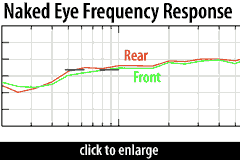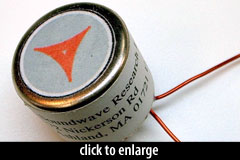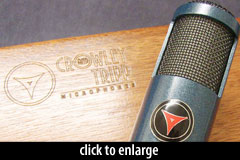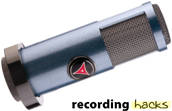 Crowley and Tripp Naked Eye
Crowley and Tripp Naked Eye
Ribbon Microphone
The Naked Eye is a unique dual-voice passive ribbon microphone. The name is derived from the design goal of having the microphone be “open to incoming sound, without excess layers of cloth or protection” which can muffle and distort sound. The design won a ProAudioReview PAR Excellence Award in 2006.
The two voices in the Naked Eye were modeled on the sounds of two of the company’s earlier ribbon microphones, the Proscenium and the Studio Vocalist. They were achieved not simply by offsetting the ribbon toward the front or rear of the microphone, as is done in the Royer R-121, but rather by tuning the acoustic impedance of the incoming soundwaves. This “impedance gradient” was realized through a combination of material selection and construction techniques.
 A graph showing the frequency response of the front and rear demonstrates the effect. The differences are not subtle. The two frequency plots track fairly closely from 80Hz–3000Hz, but vary widely above and below.
A graph showing the frequency response of the front and rear demonstrates the effect. The differences are not subtle. The two frequency plots track fairly closely from 80Hz–3000Hz, but vary widely above and below.
See also the polar graph.
The ribbon in the original Naked Eye microphone was made of aluminum, or possibly an aluminum alloy. In introducing the Roswellite material, Robert Crowley described the material it replaced:
Robert Crowley
Aluminum has been the choice for making ribbon microphone elements since day one. For small excursion, low intensity sound applications, aluminum worked out fairly well… Better alloys and mic designs nearly doubled the effective durability of ribbon mics. The Crowley and Tripp Naked Eye Standard is one such example of a higher strength aluminum ribbon that has been successful.
 The output transformer was a low-noise, high-efficiency, double-shielded design tuned specifically for the Naked Eye.
The output transformer was a low-noise, high-efficiency, double-shielded design tuned specifically for the Naked Eye.
The Naked Eye shipped in a padded wooden storage case with a “low diffraction rotary mount,” aka the “monacle” stand mount.
All Crowley and Tripp microphones were built by hand in the USA, at Soundwave Research Laboratories’ Ashland, MA facility.
 The product line was sold to Shure in 2009, and the Crowley and Tripp microphone line was officially retired on June 24, 2009.
The product line was sold to Shure in 2009, and the Crowley and Tripp microphone line was officially retired on June 24, 2009.
Electronic Musician, 2007
Though I typically use large-diaphragm condensers for voice-over work, I gave the Naked Eye a shot… and was happy with the results. The talent was a female alto… I had expected the Naked Eye’s brighter voicing to be the one we would use, but I found it a bit harsh and sibilant. [T]he darker side gave us everything we needed. The resulting audio was clean, tight, and neutral.
SoundOnSound, 2006
The Naked Eye is a delight to use. The stand adaptor is brilliantly simple but effective…
The proximity effect is fairly mild once you get more than about six inches away from the mic, but closer miking provides that characteristic larger-than-life sound that can really lift a good voice…
The Crowley and Tripp Naked Eye is also known as: Naked Eye Classic.
The mic was released in 2006.
Specifications
| Frequency Response - Bidirectional (Front of ribbon)Click Graph to Compare! |
|---|
 |
| Frequency Response - Bidirectional (Rear of ribbon)Click Graph to Compare! |
 |
| Pickup Patterns | Pads & Filters |
|---|---|
|
Bidirectional
(55 - 11,000 Hz) Bidirectional (55 - 11,000 Hz) |
|
| Ribbon Construction | Impedance | SPL/Noise |
|---|---|---|
| Front of ribbon | n/a | Self-noise: 13.0 dB(A) |
| Weight | Length | Max Diameter | Interface(s) |
|---|---|---|---|
| n/a | 132mm (5.20'') | 40mm (1.57'') |
|
| Power Specifications |
|---|
Did we get anything wrong on this page? Please let us know!


